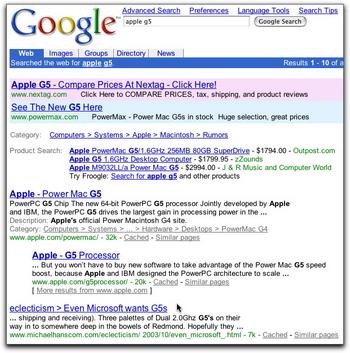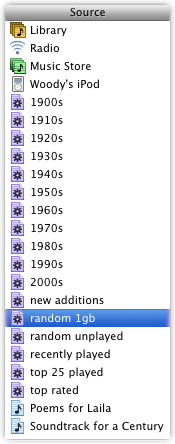
Wow. The past day has been absolutely incredible — naïve as it may seem, I really didn’t expect all of this response to come from my little adventure.
While I had to give up on linking back to every site that linked to my post simply because there were too many of them to keep track of, some of the biggest so far have been MetaFilter, The Register, and Slashdot. Crazy. I’ve also had interviews today with both MSNBC (ironic, no?) and the Seattle P-I — I’ll post links to those articles when they become available.

Update: The article in the Seattle P-I is now online (and it’s on the front page of the print edition — yikes!).
Update 2: The MSNBC article is also online.
Following up on some of the many comments that have been left on my site and others where this has been mentioned:
Yes — I made a mistake
This has been pointed out many times, sometimes more politely than others. My posting of a photo taken at the Microsoft campus was (most likely) a breach of contract. The only reason I qualify that with “most likely” is that, due to my particular employment situation (a temp worker contracted to a vendor who had an account at Microsoft), I never went through any Microsoft-specific orientation or “rules and regulations” session, so I can’t say for certain that there is a “no cameras” clause as a condition of working at or for Microsoft.
No cameras?
Now, even without knowing about a “no cameras” clause, common sense does come into play here. Had I been foolish enough to take pictures inside any of Microsoft’s buildings, of the buildings themselves, of the offices of any of the employees, or anything similar, than I would fully expect to be terminated. As I mentioned in my Of blogging and unemployment post, I thought that the picture was taken in such a way that it would not cause any issues, revealing only an unmarked truck with some computers, and a small section of loading dock that could be nearly any loading dock on any building across America.
In fact, it may very well be that the picture itself is not what caused Microsoft to decide that I was no longer welcome on their campus. Again, as I mentioned in the ‘Of blogging and unemployment’ post, it appears that it was the combination of the picture with the information about what building I was at when I took the picture that prompted them to make the decision that they did.
NDAs (Non-Disclosure Agreements)
Many people have posited that my ultimate downfall was a breach of an NDA. This may or may not be the case. Again, because of the circumstances of my position at Microsoft, I never signed a Microsoft-specific NDA — however, this does not mean that I was not bound by an NDA. I would not be at all surprised if there were some form of NDA clause as part of the contract between Microsoft and their vendors. Now, I’m not sure if my post, the picture, or the combination of the two would constitute a breach of any NDA clause that I may have been bound to. I didn’t think so when I made the post, however given recent events, that may very well have been where I was wrong.
Who’s to blame?
In the end — me. I really don’t blame Microsoft for their actions. By my best guess, they saw me as breaking the rules — whether those rules were a “no cameras” clause, an NDA, or something entirely different — and decided that rather than give me a second chance and run the risk of me doing something similar in the future, it would be better to just cut me loose before I could do any more damage.
I can (and would) swear up and down that I would never divulge any internal Microsoft information. Heck, during my tenure at the printshop, I saw a lot of information that would have gotten me fired faster than this did if I’d been so foolish as to publish it. As “evil” as Microsoft may be popularly perceived, I don’t think it’s any secret that they have many incredibly intelligent people working for them, who come up with some truly astounding ideas. I’ve seen advertising campaigns in their preplanning stages weeks before they hit the press, I’ve seen internal documentation on programs that are still in development, and I’ve seen ideas and technologies that I would love to have available on my Mac at home. None of those have ever been mentioned here in my weblog, and even now, this is the most I intend to say about them.
However — while I may not have seen my post as violating Microsoft’s security standards, someone there did. Because of that, they may feel that it’s not worth the risk of continuing to allow me access to proprietary information that I could, in theory, leak to the world.
I may not like the way that they handled this. While I didn’t plan for my post to generate the amount of attention that it’s received, it has, and now Microsoft is facing a certain amount of bad press because of that. It may have been far better for them (on a PR level) to reprimand me and have me take the post down. However, I cannot fault them for making the decision that they did, however much I wish that that they had made a different decision.
I goofed. I regret it, but the damage is done. Mea culpa, mea culpa, mea maxima culpa. ;)
Future employment
I’ve seen a lot of comments suggesting that I apply to Apple — even some stating that Apple should just give me a job. As amusing as this idea is, I have to say that even I find it entirely unrealistic.
First off, as some have pointed out, my post could be seen as indicating that I have a propensity for disclosing internal company information. That’s not likely to put me very high on the list of prospective candidates for any business, let alone one run as tightly as Apple.
More importantly, though, is the simple fact that as my resumé shows, I’m woefully under-qualified for many computer-based positions. I don’t have a college degree. I don’t have any sort of computer certification. Aside from the past eight months, I haven’t even held a position that was primarily computer based. Instead, I’ve spent ten years working in the quick-print industry, running high-end digital copiers.
This isn’t to say that I’m a computer illiterate, of course. I’ve been a fairly typical “computer geek” for most of my life. I have experience with a wide range of systems, starting with CP/M on an Osborne 1, a few different flavors of *nix, DOS and Windows based PCs, and my primary focus, Apple Macintosh computers. I like learning about how all of the bits and pieces work, and how they work together. I’ve been fascinated with HTML for years — my first website went up in 1995, and I’ve been “blogging” in one form or another since 1998 or 1999, though I only have archives dating back to November of 2000 — and while I may not be much of a designer, if I may toot my own horn for just a moment, I think that my HTML code is damn good. I’ve spent a little time mucking around with Perl, Java, and Javascript, not enough to be a programmer (by any stretch of the imagination), but enough that I can take a look at the code and at least get a general feel for what it’s doing.
All of this, though, is self-taught. And self-taught doesn’t really get you jack, for the most part, especially when it doesn’t show on your resumé. My biggest regret with all of this is that, as my position for the past eight months has been working in a prepress environment, getting digital files print ready, I was finally getting some resumé experience that could show that I really did know something about computers. Now, however, I’ve lost that position, and I’ll just have to hope that if I’m lucky, those eight months might be enough for someone to give me a chance again at some point.
In the end, it all comes down to hitting the streets, throwing my resumé around town, and seeing what comes up — and hoping that when an interviewer googles my name, all this brouhaha doesn’t scare them off!
Rent (or “Wow — you all rock.”)
While I’m sure after reading the article at The Register that many people will find this hard to believe, I originally only mentioned financial matters because I had had enough people inquire that it was easier to do it in a single post than e-mail everyone. I’ve never expected donations in the past, and I wasn’t expecting donations this time.
Quite honestly, I’m floored.
An incredible number of people have tossed a few dollars my way, and I really don’t know how to thank you all. It’s enough to ensure that my rent for the month is taken care of without having to hit my emergency stash, and just a little over (which will go for good cheap eats — like Top Ramen, the bachelor’s/college student’s/first-time-apartment-dweller’s food of choice!). Many, many thanks, karma points, and mojo out to all of you. You rock.
Surviving Slashdotting (or, “Commercial time!”)
Lastly, but definitely not least, I’ve had quite a few people inquire about the weblog itself — specifically, who hosts it, and how it’s managed to stand up to the abuse of a Slashdotting as well as it has.
My site is hosted by TypePad, from the same good people that produce MovableType. I used MovableType for quite a few years on a personal server running out of my apartment (thank goodness I’m not using that setup now — my poor lil’ G3 webserver would be in puddles on the floor by now!), moved to TypePad when I got the invitation to be part of their public beta test — and have stuck with it since.
As I’m a confessed HTML geek, I find TypePad’s pro level perfect for me. They take care of all the niggling little details of server management, and I still have full control over all the HTML code produced by the system. I can be as picky (ahem…anal) as I want about the code that my site produces, and I do what I can to ensure that the pages are as clean as possible — minimal graphics, standards compliant code that’s easy to read if someone should dive into the source, CSS for presentation, and all the rest of the current buzzword goodies.
I can’t recommend TypePad enough — or MovableType, if you prefer to handle the server end of things yourself. I’m also very grateful to them for handling my Slashdotting (their first, apparently!) with such aplomb. As far as I know, there were very few glitches over the course of the day.
Conclusion
So what have I learned from all of this? Well, firstly, and most importantly — keep my big fat mouth shut! ;)
Some people have made comments along the lines of, “this is why I blog anonymously.” I have to say, that I don’t honestly think that that’s necessarily a perfect solution. Given the well-known power of Google, it’s very easy for me to believe that many anonymous blogs are — or at least could be — far less anonymous than their authors might believe. A comment here, a phrase there, a certain choice of words, and suddenly, someone’s put the pieces together (“They said that their birthday was on or around this date, they got together with this group of friends here, they took a trip to Disneyland here…”) and they are suddenly “outed”.
I made the conscious choice a few months back not to blog anonymously. Prompted by a post by Anil Dash, I decided that given the All-Seeing Eye of Google, I would rather do what I could to “own” my own name. I stopped using my prior online pseudonym of ‘djwudi’, began using my given name of Michael Hanscom whenever leaving comments on sites, and registered the www.michaelhanscom.com domain name. To me, the ability to have some amount of control in ensuring that information that is connected to my name is actually connected to me is worth the risk of situations like what I just went through.
Basically, it all boils down to making sure that you know just what your employer would or would not be comfortable with you mentioning on your weblog — and if there’s any doubt, don’t mention it. I didn’t, and it got me canned. You shouldn’t let the same thing happen to you.
Thanks much for all the attention, comments, and food for thought over the past few days. It’s been a bit overwhelming, but one hell of a ride.





 Another meme that Kottke pointed out —
Another meme that Kottke pointed out —